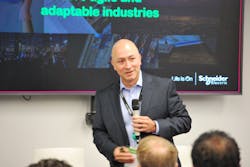The value of reimagining process automation
Michael Martinez, EcoStruxure Foxboro DCS Global Leader at Schneider Electric, understands why the conversations surrounding process automation need to change. Global trends and recent events, such as the pandemic and supply chain challenges, have left end users demanding more value from their legacy industrial operations. These days, dynamic markets worldwide require industries to be more agile and adaptable.
The catalyst for fulfilling those demands is a reimagination of process automation, Martinez told an audience of Schneider Electric customers at its user forum in May in Foxboro, Mass. “Reimagining automation” was the theme of the multiday event, with several breakout sessions addressing just how the company is reimagining process automation as it innovates and updates its product lines for open systems and interoperability. After all, much of control, like just about everything else, finds efficiency by operating via cloud-computing.
“One thing I and probably all of you have recognized over the last couple of decades is we’ve always put hardware first,” Martinez said.
He admits this was the basis of a lot of investment in the Foxboro distributed control system over the last 35 years. However, given the way the world has changed, particularly as everything from planning meetings to plant operations continues to adapt to the cloud, the primary focus on hardware has become “a little bit backward.” Rather, he says, it’s time to reimagine process automation for open systems.
End users agree. In a recent survey commissioned by Schneider Electric, more than 80% of industries consider open systems and interoperability as important capabilities when selecting vendors for their control system. In addition, 95% of participants reported that, when selecting new controls systems, interoperability is very important or important.
With those kinds of expectations, there’s no doubt conversations in innovation labs are taking on a different tone these days.
Open Systems
Thinking differently about process automation revolves around three important avenues: open systems, empowering collaboration and democratizing technology.
There are three different ways to think about open systems, according to Martinez. The first model of open systems in today’s process industries is one that says everything can talk to everything else. It creates a common language, such as OPC Unified Architecture (OPC UA). “If everything speaks OPC UA and we have OPC UA databases, then regardless of all of the systems that we have underneath, the challenges of configuring those systems, maintaining the licenses, and getting the proprietary hardware, is open,” Martinez said.
Another definition implies that, when you buy anything from a vendor, it will work with everything from that vendor. “That's another definition of open, but it's not the definition of open that Schneider Electric uses,” Martinez adds.
Schneider Electric opts for a definition of open systems in which software and hardware are separated. The goal is to decouple them, so end users can experience automation in a new way that's portable, much like how listening to music has decoupled from any one physical sound system.
Using this approach, solutions aren’t hardware dependent; they don’t require users to change out hardware because of a scheduled hardware lifecycle. Users won’t be compelled to reconfigure or rebuild their entire applications.
Empowering collaboration
Another aspect of reimagining process automation is empowering collaboration. This is where engineering gets back to process first, according to Martinez. “Today, when we think about automation systems or even when we walk into a customer’s site, what's the first thing I want to see? It’s the control room—where the controllers are,” he says. “That's because we're so hardware focused. But as we move into the future, we need to change that conversation.”
Changing this discussion will take effort from both instrumentation providers and end users. Nowadays, their talks often start with specification sheets. But Martinez points out it’s really all about making good products that give customers what they need. This means starting the conversation with the process and what the end user is trying to accomplish.
“Whether it’s production, sustainability or ESG goals, you name it,” he says. “All of them are achievable when we work together and don't just transact.”
Democratizing process automation
Democratizing technology is about accessibility and easily incorporating new ideas. It lets applications and configuration interfaces be based on industry standards that are accessible to everyone.
“It's a language that we speak, that we must speak, to get our systems to do what we want,” said Martinez.
He adds that locked and proprietary systems limit the ability of experts in innovation labs to add value to processes and contribute as soon as they arrive. Instead, they must be trained in “ancient ways” before they can add value to the organization.
At a time when many industries are struggling to bring in the next generation of automation professionals, how can process automation companies attract new talent if they can’t or won’t open the full toolbox for them to use?
Martinez points to partnerships with UniversalAutomation.org, a group of member companies working to enable vendors, end users and academics to share a common automation software layer regardless of brand. He adds the industry can extend a hand to educational institutions, so it will educate the next generation of automation professionals about this open way of thinking. It’s a vital step in the future of process automation because it ensures the skills that new process automation professional gain can be immediately applied to their area of expertise and industry processes.
“It makes it very easy for them to add value immediately,” Martinez says.
While industry has historically focused on profit and financial performance, open systems, empowering collaboration among vendors and end users and embracing next generation ideas ties a company directly to purpose-driven goals.
About the Author

Leaders relevant to this article:

